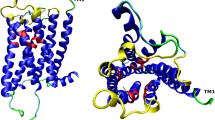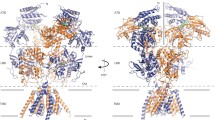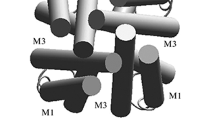Abstract
Studies of the effects of analogs of N-phthalmoyl-L-glutamic acid (PhGA, experiments on freshly isolated hippocampal neurons of rats and on mice using intracerebroventricular injection) were compared with the molecular modeling studies. Transmembrane currents evoked by applications of NMDA receptor agonists were recorded using a patch-clamp technique. Interaction of phGA derivatives with the NMDA receptors was examined by comparing their agonistic activity with that of L-aspartate. It was found that the derivatives (iso- andtere-PhGA), which contain three carboxylic groups, display a strong agonistic activity. The absence of carboxylic groups in the molecule of an agonist and lengthening of the methylene chain in the aliphatic part of the molecule result in a drop in agonistic activity.
Similar content being viewed by others
References
C. Ikonomidou and L. Turski, “Neurodegenerative disorders: clues from glutamate and energy metabolism,”Crit. Rev. Neurobiol.,10, 239–263 (1996).
B. S. Meldrum, “The role of glutamate in epilepsy and other CNS disorders,”Neurology,44, 14–23 (1994).
P. T. Francis, N. R. Sims, A. W., Procter, and D. Bowen, “Cortical pyramidal neurones loss may cause glutamatergic hypoactivity and cognitive impairment in Alzheimer’s disease: investigative and therapeutic perspectives,”J. Neurochem.,60, 1589–1604 (1993).
A. B. Young, J. T. Greenamyre Z. Hollingsworth, et al., “NMDA receptor loses in putamen from patients with Huntington’s disease,”Science,241, 981–983 (1988).
T. Klockgether and L. Turski, “Toward an understanding of the role of glutamate in experimental Parkinsonism: agonist-sensitive sites in the basal ganglia,”Ann. Neurol.,34, 585–593 (1993).
S. A. Lipton, “HIV-related neuronal injury. Potential therapeutic intervention with calcium channel antagonists and NMDA antagonists,”Mol. Neurobiol.,8, 181–196 (1994).
W. E. Meller, G. Pergande, H. Ushijima, et al., “Neurotoxicity in rat cortical cells caused by N-methyl-D-asparate (NMDA) and gp 120 of HIV-1: induction and pharmacological intervention,”Prog. Mol. Subcell. Biol.,16, 44–57 (1996).
A. Yu. Bespalov, M. A. Dumpis, L. B. Piotrovsky, and E. E. Zvartau, “Excitatory amino acid receptor antagonist kynurenic acid attenuates rewarding potential of morphine,”Eur. J. Pharmacol.,264, 494–496 (1994).
M. E. Wolf and M. Jeziorski, “Coadministration of MK-801 with amphetamine, cocaine or morphine prevents rather than transiently masks the development of behavioral sensitization,”Brain Res.,613, 291–296 (1993).
G. P. Reynolds, “Development in the drug treatment of schizophrenia,”Trends Pharmacol. Sci.,13, 116–121 (1992).
J. Willets, R. L. Balster, and J. D. Leander, “The behavioral pharmacology of NMDA receptor antagonists,”Trends Pharmacol. Sci.,11, 423–428 (1990).
B. Ebert, U. Madsen, K. K. Soby, and P. Krogsgaard-Larsen, “Functional partial agonism at ionotropic excitatory amino acid receptors,”Neurochem. Int.,29, 309–316 (1996).
J. C. Watkins, P. Krogsgaard-Larsen, and T. Honore, “Structure-activity relationships in the development of excitatory amino acid receptor agonists and competitive antagonists,”Trends Pharmacol. Sci.,11, 25–33 (1990).
J. C. Watkins, “Some chemical highlights in the development of excitatory amino acid pharmacology,”Can. J. Physiol. Pharmacol.,69, 1064–1075 (1991).
J. J. Hansen and P. Krogsgaard-Larsen, “Structural, conformational, and stereochemical requirements of central excitatory amino acid receptors,”Med. Res. Rev.,10, 55–94 (1991).
J. T. Coyle, R. Blakely, R. Zaczek, et al. “Acidic peptides in brain: do they act as putative glutamatergic synapses?,”Adv. Exp. Med. Biol.,203, 375–384 (1986).
H. M. Valivullah, J. Lancaster, P. M. Sweetnam, and J. H. Neale, “Interactions between N-acetylaspartylglutamate and AMPA, kainate, and NMDA binding sites,”J. Neurochem.,63, 1714–1716 (1994).
N. I. Kiskin, A. Ya. Tsyndrenko, M. A. Dumpis, et al., “A novel selective NMDA agonist, N-phthalamoyl-L-glutamic acid (PhGA),”NeuroReport,2, 29–32 (1991).
O. N. Koreshonkov, P. V. Perestenko, M. A. Dumpis, and L. B. Piotrovsky, “The effect of N-phthalamoyl-L-glutamic acid (PhGA), a novel selective NMDA receptors agonist, on the binding of [3H]-L-Glu with the synaptic membranes of human hippocampus,”Byull. Éksp. Biol. Med.,6, 563–565 (1992).
A. P. Garyaev O. V. Kononov, M. A. Dumpis, and L. B. Piotrovsky, “The excitatory action on CNS of N-acyl derivatives of glutamic, and aspartic acids,”Khim.-Farm. Zh.,5, 20–25 (1990).
O. N. Koreshonkov, P. V. Perestenko, M. A. Dumpis, and L. B. Piotrovsky, “The interaction of structural analogues of N-phthalamoyl-L-glutamic acid with the synaptic membranes of human hippocampus,”Khim.-Farm. Zh.,8, 6–8 (1995).
I. V. Chizhmakov, N. I. Kiskin, and O. A. Krishtal, “Two types of steady-state desensitization of N-methyl-D-aspartate receptor in isolated hippocampal neurones of rat,”J. Physiol.,448, 453–472 (1992).
A. P. Garyaev, M. A. Dumpis, L. N. Poznyakova, et al., “Excitatory action of some asparate- and glutamate-containing dipeptides after intracerebroventricular injection in mice,”Eur. J. Pharmacol.,197, 157–160 (1991).
M. Saunders, “Stochastic exploration of molecular mechanics of energy surfaces. Hunting for the global minimum,”J. Am. Chem. Soc.,109, 3150–3159 (1987).
U. Burkert and N. L. Allinger,Molecular Mechanics, Washington (1982).
D. Ortwine, T. Malone, C. F. Bigge, et al., “Generation of N-methyl-D-aspartate agonist and competitive antagonist pharmacophore model. Design and synthesis of phosphonoalkyl-substituted tetrahydroisoquinolines as novel antagonists,”J. Med. Chem.,35, 1345–1370 (1992).
A. Dorville, I. McCort-Tranchepain, D. Vichard, et al., “Preferred antagonist binding state of the NMDA receptor: synthesis, pharmacology, and computer modelling of (phosphonomethyl)phenylalanine derivatives,”J. Med. Chem.,35, 2551–2562 (1992).
Sybyl 5.3, Tripos Ass. Inc. (1989).
C. F. Bigge, C. Humblet, G. Johnson, et al., “Design, synthesis and molecular modelling of phosphoalkyltetrahydroisoquinolines as competitive NMDA antagonists,” in:Trends in Medicinal Chemistry’90, Blackwell, London (1992), pp. 153–160.
A. J. Hutchinson M. Williams, C. Angst, et al., “4-(phosphoalkyl)-and 4-(phosphonoalkenyl)-2-piperidine carboxylic acids: synthesis, activity at N-methyl-D-aspartic receptors, and anticonvulsant activity,”J. Med. Chem.,32, 2171–2178 (1989).
J. C. Watkins and H. J. Olverman, “Agonists and antagonists for excitatory amino acid receptors,”Trends Neurosci,10, 265–272 (1987).
G. E. Fagg, J. Baud, R. Hall, and J. Dindwall, “Do agonists and competitive antagonists bind to distinct sites of the NMDA receptors?” in:Frontiers in Excitatory Amino Acid Research, Alan, R. Liss (1988), pp. 59–66.
Author information
Authors and Affiliations
Rights and permissions
About this article
Cite this article
Zhenochin, S.P., Piotrovsky, L.B., Dumpis, M.A. et al. Analogs of a superacidic NMDA receptor agonist, N-phthalamoyl-L-glutamic acid (PhGA): Activity and mode of interaction with the receptor recognition site. Neurophysiology 31, 295–303 (1999). https://doi.org/10.1007/BF02515110
Received:
Issue Date:
DOI: https://doi.org/10.1007/BF02515110




